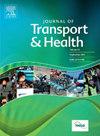COVID-19 risk perceptions among public transportation drivers and users in Lebanon: A cross-sectional study
IF 3.3
3区 工程技术
Q2 PUBLIC, ENVIRONMENTAL & OCCUPATIONAL HEALTH
引用次数: 0
Abstract
Objectives
This study evaluates the perceived severity of and susceptibility to COVID-19 among public transportation drivers and users after lifting COVID-19 restrictions in Lebanon.
Study design
Cross-sectional study.
Methods
Data was collected through face-to-face survey questionnaires. Proportionate sampling method was used to recruit 854 public transportation drivers and users between August and October of 2024 from various Lebanese governorates (Beirut, Mount Lebanon, North, South and Beqaa). An Arabic anonymous questionnaire was used to measure participants' characteristics, COVID-19 risk perceptions, and users' preferences, guided by the Health Belief Model and Oliver's Expectation Disconfirmation theory. Descriptive statistics, Students' t-test, Mann Whitney test, and linear regression analyses were performed (statistical significance was set at P < 0.025).
Results
The perceived susceptibility to COVID-19 scores were significantly higher among public transportation users (3.3/5) compared to drivers (3.1/5), P = 0.015. Public transportation users felt at higher risk of getting COVID-19 while using vans/buses (51.5 %, n = 201) compared to taxi cabs (39.4 %, n = 155). They preferred if drivers disinfect their vehicles (76.5 %), preferred sharing a ride with others who wear a face mask (71.4 %), preferred if drivers wear masks (69.7 %), preferred if the transport vehicle had a protective shield (65.5 %), and preferred drivers who get vaccinated against COVID-19 (58.8 %). They disagreed that there is a need for a mandate to vaccinate drivers against COVID-19 (59.6 %). Public transportation users not having a health insurance, those who wear a face mask during a ride, and being unemployed reported higher perceived severity to or susceptibility toward COVID-19. Among drivers, being married, receiving COVID-19 vaccine, wearing a face mask, and performing physical activities were associated with higher perceived severity to or susceptibility towards COVID-19.
Conclusions
Findings in this study aid in persuading public transportation drivers to better comply with precautionary measures against COVID-19, thus promoting a safer public transportation system.
黎巴嫩公共交通司机和用户对COVID-19风险的认知:一项横断面研究
目的本研究评估黎巴嫩解除COVID-19限制后公共交通司机和用户对COVID-19的严重程度和易感性的感知。研究设计横断面研究。方法采用面对面问卷调查的方式收集资料。采用比例抽样方法,于2024年8月至10月从黎巴嫩各省份(贝鲁特、黎巴嫩山、北部、南部和贝卡)招募了854名公共交通司机和用户。采用阿拉伯语匿名问卷,在健康信念模型和奥利弗期望失证理论的指导下,测量参与者的特征、COVID-19风险感知和用户偏好。进行描述性统计、学生t检验、Mann Whitney检验和线性回归分析(P <为统计学显著性;0.025)。结果公共交通使用者(3.3/5)对COVID-19的感知易感性得分显著高于司机(3.1/5),P = 0.015。与乘坐出租车(39.4%,n = 155)相比,乘坐公共交通工具的人认为乘坐面包车/公交车感染新冠病毒的风险更高(51.5%,n = 201)。他们更喜欢司机对车辆进行消毒(76.5%),更喜欢与戴口罩的人共乘(71.4%),更喜欢司机戴口罩(69.7%),更喜欢运输车辆有防护盾(65.5%),更喜欢司机接种新冠病毒疫苗(58.8%)。他们不认为有必要强制要求司机接种COVID-19疫苗(59.6%)。没有健康保险的公共交通使用者、在乘车时戴口罩的人以及失业的人报告说,他们对COVID-19的严重程度或易感性更高。在司机中,已婚、接种COVID-19疫苗、戴口罩和进行体育活动与对COVID-19的严重程度或易感性较高相关。本研究的发现有助于说服公共交通司机更好地遵守COVID-19预防措施,从而促进更安全的公共交通系统。
本文章由计算机程序翻译,如有差异,请以英文原文为准。
求助全文
约1分钟内获得全文
求助全文

 求助内容:
求助内容: 应助结果提醒方式:
应助结果提醒方式:


